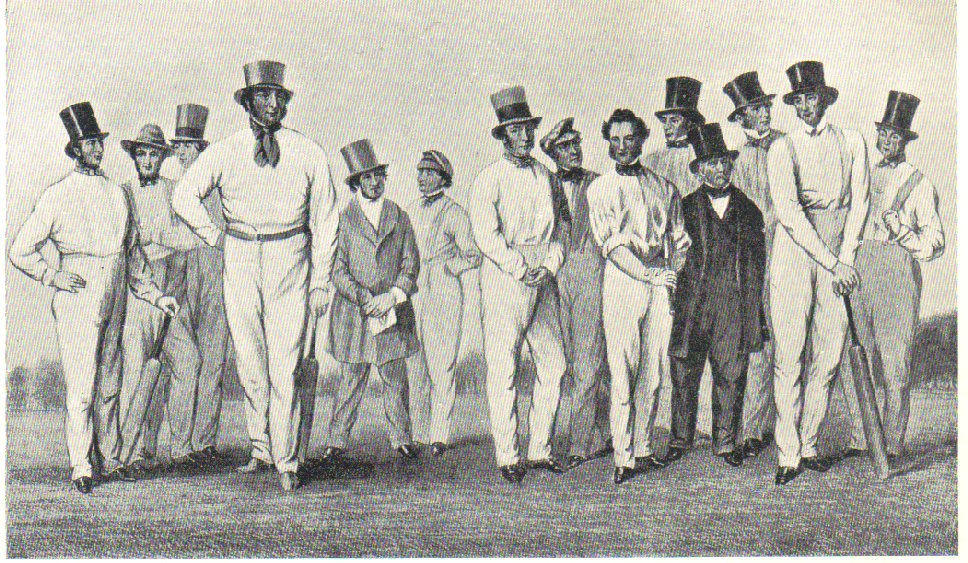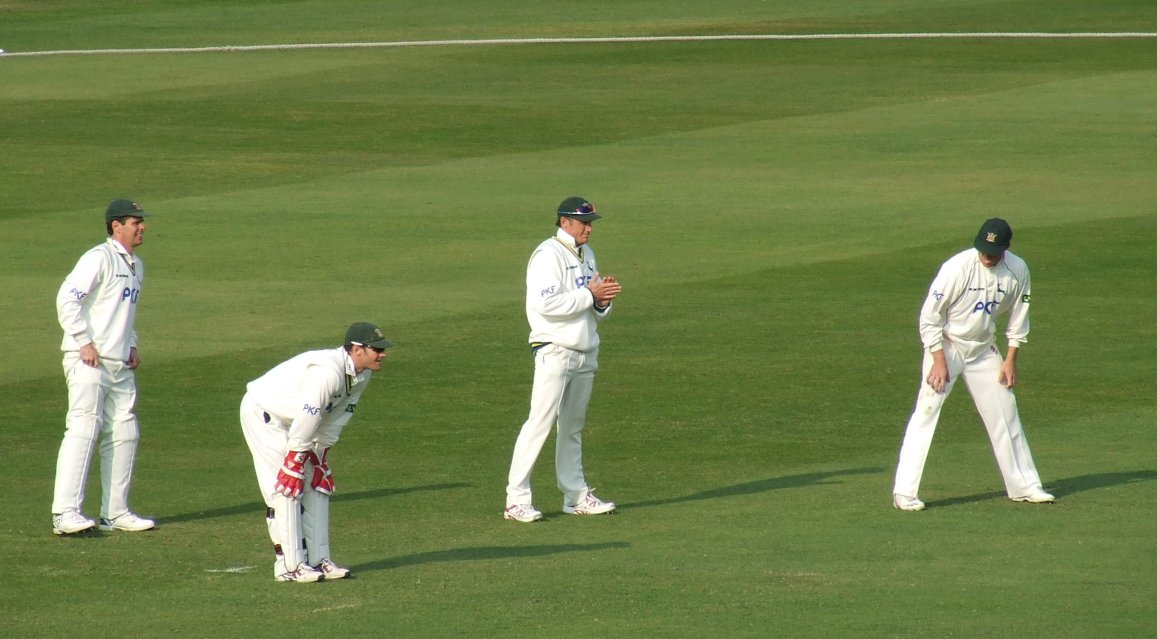|
Line And Length
Line and length in cricket refers to the direction and point of bouncing on the pitch of a delivery. The two concepts are frequently discussed together. Line The line of a delivery is the direction of its trajectory measured in the horizontal plane. More simply, it is a measure of how far to the left or right the ball is travelling, compared to a line drawn straight down the pitch. It is usually referred to in terms of the directions off (away in front of the batsman) and leg (in towards or behind the batsman), rather than left and right, however. Different lines that the ball may be said to be travelling on may be towards off stump, middle stump or leg stump, outside leg stump, or outside off stump. Balls on a line outside off stump may be said to be in the "corridor of uncertainty" if they are within 12 inches of the line of off stump. Wider deliveries may be said to be giving a batsman "width". Balls delivered on a line outside leg stump are often referred to as "going dow ... [...More Info...] [...Related Items...] OR: [Wikipedia] [Google] [Baidu] |
Cricket
Cricket is a bat-and-ball game played between two teams of eleven players on a field at the centre of which is a pitch with a wicket at each end, each comprising two bails balanced on three stumps. The batting side scores runs by striking the ball bowled at one of the wickets with the bat and then running between the wickets, while the bowling and fielding side tries to prevent this (by preventing the ball from leaving the field, and getting the ball to either wicket) and dismiss each batter (so they are "out"). Means of dismissal include being bowled, when the ball hits the stumps and dislodges the bails, and by the fielding side either catching the ball after it is hit by the bat, but before it hits the ground, or hitting a wicket with the ball before a batter can cross the crease in front of the wicket. When ten batters have been dismissed, the innings ends and the teams swap roles. The game is adjudicated by two umpires, aided by a third umpire and match r ... [...More Info...] [...Related Items...] OR: [Wikipedia] [Google] [Baidu] |
Bowled
In cricket, the term bowled has several meanings. First, is the act of propelling the ball towards the wicket defended by a batsman. Second, it is a method of dismissing a batsman, by hitting the wicket with a ball delivered by the bowler. (The term "bowled out" is sometimes used instead.) Third, it is used in scoring to indicate which bowler is credited with dismissing a batsman, when the batsman is dismissed by being bowled, leg before wicket, caught, stumped, or hit wicket. Delivery of a ball Dismissal of a batsman This method of dismissal is covered by Law 32 of the ''Laws of Cricket''. A batter is Bowled if his or her wicket is put down by a ball delivered by the bowler. It is irrelevant whether the ball has touched the bat, glove, or any part of the batsman before going on to put down the wicket, though it may not touch another player or an umpire before doing so. Such rules mean that bowled is the most obvious of dismissals: almost never requiring an appeal to ... [...More Info...] [...Related Items...] OR: [Wikipedia] [Google] [Baidu] |
Length (cricket)
Length is a measure of distance. In the International System of Quantities, length is a quantity with dimension distance. In most systems of measurement a base unit for length is chosen, from which all other units are derived. In the International System of Units (SI) system the base unit for length is the metre. Length is commonly understood to mean the most extended dimension of a fixed object. However, this is not always the case and may depend on the position the object is in. Various terms for the length of a fixed object are used, and these include height, which is vertical length or vertical extent, and width, breadth or depth. Height is used when there is a base from which vertical measurements can be taken. Width or breadth usually refer to a shorter dimension when length is the longest one. Depth is used for the third dimension of a three dimensional object. Length is the measure of one spatial dimension, whereas area is a measure of two dimensions (length squar ... [...More Info...] [...Related Items...] OR: [Wikipedia] [Google] [Baidu] |
Bodyline
Bodyline, also known as fast leg theory bowling, was a cricketing tactic devised by the English cricket team for their 1932–33 Ashes tour of Australia. It was designed to combat the extraordinary batting skill of Australia's leading batsman, Don Bradman. A bodyline delivery was one in which the cricket ball was bowled, at pace, at the body of the batsman in the expectation that when he defended himself with his bat a resulting deflection could be caught by one of several fielders standing close by on the leg side. Critics of the tactic considered it intimidating and physically threatening in a game that was traditionally supposed to uphold conventions of sportsmanship. The England team's use of the tactic was perceived by some, both in Australia and England, as overly aggressive or even unfair, and caused controversy that rose to such a level that it threatened diplomatic relations between the two countries before the situation was calmed.Frith, pp. 241–59. Althoug ... [...More Info...] [...Related Items...] OR: [Wikipedia] [Google] [Baidu] |
Australia
Australia, officially the Commonwealth of Australia, is a sovereign ''Sovereign'' is a title which can be applied to the highest leader in various categories. The word is borrowed from Old French , which is ultimately derived from the Latin , meaning 'above'. The roles of a sovereign vary from monarch, ruler or ... country comprising the mainland of the Australian continent, the island of Tasmania, and numerous smaller islands. With an area of , Australia is the largest country by area in Oceania and the world's sixth-largest country. Australia is the oldest, flattest, and driest inhabited continent, with the least fertile soils. It is a megadiverse country, and its size gives it a wide variety of landscapes and climates, with deserts in the centre, tropical Forests of Australia, rainforests in the north-east, and List of mountains in Australia, mountain ranges in the south-east. The ancestors of Aboriginal Australians began arriving from south east Asia approx ... [...More Info...] [...Related Items...] OR: [Wikipedia] [Google] [Baidu] |
England Cricket Team
The England cricket team represents England and Wales in international cricket. Since 1997, it has been governed by the England and Wales Cricket Board (ECB), having been previously governed by Marylebone Cricket Club (the MCC) since 1903. England, as a founding nation, is a Full Member of the International Cricket Council (ICC) with Test, One Day International (ODI) and Twenty20 International (T20I) status. Until the 1990s, Scottish and Irish players also played for England as those countries were not yet ICC members in their own right. England and Australia were the first teams to play a Test match (15–19 March 1877), and along with South Africa, these nations formed the Imperial Cricket Conference (the predecessor to today's International Cricket Council) on 15 June 1909. England and Australia also played the first ODI on 5 January 1971. England's first T20I was played on 13 June 2005, once more against Australia. , England have played 1,058 Test matches, winning 387 an ... [...More Info...] [...Related Items...] OR: [Wikipedia] [Google] [Baidu] |
Fielding Positions In Cricket
Fielding in the sport of cricket is the action of fielders in collecting the ball after it is struck by the striking batter, to limit the number of runs that the striker scores and/or to get a batter out by either catching a hit ball before it bounces, or by running out either batter before they can complete the run they are currently attempting. There are a number of recognised fielding positions, and they can be categorised into the offside and leg side of the field. Fielding also involves preventing the ball from going to or over the edge of the field (which would result in runs being scored by the batting team in the form of a boundary). A ''fielder'' or ''fieldsman'' may field the ball with any part of his body. However, if while the ball is in play he wilfully fields it otherwise (e.g. by using his hat), the ball becomes dead and five penalty runs are awarded to the batting side, unless the ball previously struck a batter not attempting to hit or avoid the ball ... [...More Info...] [...Related Items...] OR: [Wikipedia] [Google] [Baidu] |
Stump (cricket)
In cricket Cricket is a bat-and-ball game played between two teams of eleven players on a field at the centre of which is a pitch with a wicket at each end, each comprising two bails balanced on three stumps. The batting side scores runs by st ..., the stumps are the three vertical posts that support the bails and form the wicket. '' Stumping'' or ''being stumped'' is a method of dismissing a batsman. The umpire ''calling stumps'' means the play is over for the day. Part of the wicket The stumps are three vertical posts which support two bails. The stumps and bails are usually made of wood, most commonly ash, and together form a wicket at each end of the pitch. The overall width of each wicket is 9 inches (22.9 cm). Each stump is 28 inches (71.1 cm) tall with maximum and minimum diameters of 1 inches (3.81 cm) and 1 inches (3.49 cm). They have a spike at one end for inserting into the ground, and the other end has a U-shaped ... [...More Info...] [...Related Items...] OR: [Wikipedia] [Google] [Baidu] |
Leg Before Wicket
Leg before wicket (lbw) is one of the ways in which a batsman can be dismissed in the sport of cricket. Following an appeal by the fielding side, the umpire may rule a batter out lbw if the ball would have struck the wicket but was instead intercepted by any part of the batter's body (except the hand holding the bat). The umpire's decision will depend on a number of criteria, including where the ball pitched, whether the ball hit in line with the wickets, the ball's expected future trajectory after hitting the batsman, and whether the batter was attempting to hit the ball. Leg before wicket first appeared in the laws of cricket in 1774, as batsmen began to use their pads to prevent the ball hitting their wicket. Over several years, refinements were made to clarify where the ball should pitch and to remove the element of interpreting the batsman's intentions. The 1839 version of the law used a wording that remained in place for nearly 100 years. However, from the latter ... [...More Info...] [...Related Items...] OR: [Wikipedia] [Google] [Baidu] |
Dismissal (cricket)
In cricket, a dismissal occurs when a batter's innings is brought to an end by the opposing team. Other terms used are the batsman being out, the batting side losing a wicket, and the fielding side taking a wicket. The ball becomes dead (so no further runs can be scored off that delivery), and the dismissed batter must leave the field of play for the rest of their team's innings, to be replaced by a team-mate. A team's innings ends if ten of the eleven team members are dismissed. Players bat in pairs so, when only one batter is not out, it is not possible for the team to bat any longer. This is known as ''dismissing'' or ''bowling out'' the batting team, who are said to be '' all out''. The most common methods of dismissing a batter are (in descending order of frequency): caught, bowled, leg before wicket, run out, and stumped. Of these, the leg before wicket and stumped methods of dismissal can be seen as related to, or being special cases of, the bowled and run out ... [...More Info...] [...Related Items...] OR: [Wikipedia] [Google] [Baidu] |
Pitch (cricket)
In the game of cricket, the cricket pitch consists of the central strip of the cricket field between the wickets. It is long (1 chain) and wide. The surface is flat and is normally covered with extremely short grass, but can be completely dry or dusty soil with barely any grass or, in some circumstances (that are rarely seen in high level cricket), made from an artificial material. Over the course of a cricket match, the pitch is not repaired or altered other than in special circumstances - meaning that it will change condition. Any grass on the pitch in the game's first over, for example, may have disappeared by twentieth over due to wear. As almost all deliveries bowled will bounce off the pitch towards the batter, the state and type of a cricket pitch can significantly affect the outcome of a match. For example, a dusty, very dry, pitch will favour spin bowling because the ball will grip more on a dusty pitch - giving the team with the superior spin bowlers a significan ... [...More Info...] [...Related Items...] OR: [Wikipedia] [Google] [Baidu] |
Wicket
In cricket, the term wicket has several meanings: * It is one of the two sets of three stumps and two bails at either end of the pitch. The fielding team's players can hit the wicket with the ball in a number of ways to get a batsman out. ** The wicket is guarded by a batsman who, with his bat (and sometimes with his pads, but see the laws on LBW, leg before wicket), attempts to prevent the ball from hitting the wicket (if it does, he is bowled out) and to score runs where possible. * Through metonymic usage, the dismissal of a batsman is known as the ''taking of a wicket'', * The cricket pitch itself is sometimes referred to as ''the wicket''. History The origin of the word is from wicket gate, a small gate. Originally, cricket wickets had only two stumps and one bail and looked like a gate, much like the wicket used in the North American game of wicket. The third (middle) stump was introduced in 1775, after Lumpy Stevens bowled three successive deliveries to ... [...More Info...] [...Related Items...] OR: [Wikipedia] [Google] [Baidu] |






.jpg)
